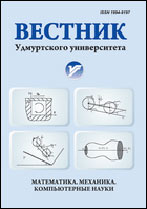|
This article is cited in 1 scientific paper (total in 1 paper)
MATHEMATICS
The Wallman compactifier and its application for investigation of the abstract attainability problem
E. G. Pytkeevab, A. G. Chentsovab
a N. N. Krasovskii Institute of Mathematics and Mechanics, Ural Branch of the Russian Academy of Sciences, ul. S. Kovalevskoi, 16, Yekaterinburg, 620990, Russia
b Ural Federal University, ul. Mira, 19, Yekaterinburg, 620002, Russia
Abstract:
The attainability problem with asymptotic constraints is considered. Such constraints can arise under weakening of constraints that are standard in control theory: phase constraints, boundary and intermediate conditions; trajectories of a system must satisfy these constraints. But asymptotic constraints can arise from the beginning as a characterization of trends in the implementation of desired behavior. For example, one can speak of implementation of powerful control impulses with vanishingly small duration. In this case, it is hard to tell whether any standard constraints are weakened. So, we have a set of complicating conditions with each of which we can juxtapose some analog of the attainability domain in control theory and (more precisely) the image of a subset of the usual solution space under the action of a given operator. In this paper, we investigate questions concerning the structure of an attraction set arising as an analog of the attainability domain. The investigation scheme is based on the application of a special way of extending solution space which admits a natural analogy with Wallman extension used in general topology. Then it is natural to suppose that the space of usual solutions is endowed with a topology (usually, it is a $T_1$-space that is explored in this case). In this connection, questions concerning the replacement of sets forming asymptotic constraints by closures and interiors are addressed. Partially, questions associated with representation of the interior of the set of admissible generalized elements that form an auxiliary attraction set are discussed.
Keywords:
asymptotic constraints, extension of a problem, topology.
Received: 19.03.2018
Citation:
E. G. Pytkeev, A. G. Chentsov, “The Wallman compactifier and its application for investigation of the abstract attainability problem”, Vestn. Udmurtsk. Univ. Mat. Mekh. Komp. Nauki, 28:2 (2018), 199–212
Linking options:
https://www.mathnet.ru/eng/vuu631 https://www.mathnet.ru/eng/vuu/v28/i2/p199
|

| Statistics & downloads: |
| Abstract page: | 422 | | Full-text PDF : | 306 | | References: | 39 |
|




 Contact us:
Contact us: Terms of Use
Terms of Use
 Registration to the website
Registration to the website Logotypes
Logotypes








 Citation in format
Citation in format 
